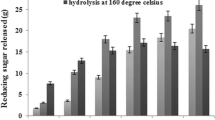Abstract
Rice husk is one of the most abundant types of lignocellulosic biomass. Because of its significant amount of sugars, such as cellulose and hemicellulose, it can be used for the production of biofuels such as bioethanol. However, the complex structure of lignocellulosic biomass, consisting of cellulose, hemicellulose and lignin, is resistant to degradation, which limits biomass utilization for ethanol production. The protection of cellulose by lignin contributes to the recalcitrance of lignocelluloses to hydrolysis. Therefore, we conducted steam-explosion treatment as pretreatment of rice husk. However, recombinant Escherichia coli KO11 did not ferment the reducing sugar solution obtained by enzymatic saccharification of steam-exploded rice husk. When the steam-exploded rice husk was washed with hot water to remove inhibitory substances and M9 medium (without glucose) was used as a fermentation medium, E. coli KO11 completely fermented the reducing sugar solution obtained by enzymatic saccharification of hot water washing-treated steam-exploded rice husk to ethanol. We report here the efficient production of bioethanol using steam-exploded rice husk.







Similar content being viewed by others
References
Abbas A, Ansumali S (2010) Global potential of rice husk as a renewable feedstock for ethanol biofuel production. Bioenergy Res 3:328–334
Balat M, Balat H, Öz C (2008) Progress in bioethanol processing. Prog Energy Combust Sci 34:551–573
Beldman G, Searle-van leeuwen MF, Rombouts FM, Voragen FGJ (1985) The cellulase of Trichoderma viride purification, characterization and comparison of all detectable endoglucanases, exoglucanases and ß-glucosidases. Eur J Biochem 146:301–308
Bin Y, Hongzhang C (2010) Effect of the ash on enzymatic hydrolysis of steam-exploded rice straw. Bioresour Technol 101:9114–9119
Miller GL (1959) Use of dinitrosalicylic acid reagent for determination of reducing sugar. Anal Chem 31:426–428
Moniruzzaman M, Ingram LO (1998) Ethanol production from dilute acid hydrolysate of rice hulls using genetically engineered Escherichia coli. Biotechnol Lett 20:943–947
Ohta K, Beall DS, Mejia JP, Shanmugam KT, Ingram LO (1991) Genetic improvement of Escherichia coli for ethanol production: chromosomal integration of Zymomonas mobilis genes encoding pyruvate decarboxylase and alcohol dehydrogenase II. Appl Environ Microbiol 57:893–900
Ramos LP (2003) The chemistry involved in the steam treatment of lignocellulosic materials. Quim Nova 26:863–871
Sarkar N, Ghosh SK, Bannerjee S, Aikat K (2012) Bioethanol production from agricultural wastes: an review. Renew Energy 37:19–37
Taherzadeh MJ, Gustafsson L, Niklasson C, Lidén G (2000) Inhibition effects of furfural on aerobic batch cultivation of Saccharomyces cerevisiae growing on ethanol and/or acetic acid. J Biosci Bioeng 90:374–380
Takahashi CM, de Carvalho Lima KG, Takahashi DF, Alterthum F (2000) Fermentation of sugar cane bagasse hemicellulosic hydrolysate and sugar mixtures to ethanol by recombinant Escherichia coli KO11. World J Microbiol Biotechnol 16:829–834
Tanahashi T, Tamabuchi K, Goto T, Aoki T, Karina M, Higuchi T (1988) Characterization of steam-explodeed wood II: chemical changes of wood components by steam explosion. Wood Res 75:1–12
Wang X, Yomano LP, Lee JY, York SW, Zheng H, Mullinnix MT, Shanmugam KT, Ingram LO (2013) Engineering furfural tolerance in Escherichia coli improves the fermentation of lignocellulosic sugars into renewable chemicals. Proc Natl Acad Sci USA 110:4021–4026
Acknowledgements
This work was supported in part by a Grant for the Program for the Strategic Research Foundation at Private Universities S1101017 since April 2011 (to NS).
Author information
Authors and Affiliations
Corresponding author
Ethics declarations
Conflict of interest
The authors declare that they have no competing interests.
Rights and permissions
About this article
Cite this article
Tabata, T., Yoshiba, Y., Takashina, T. et al. Bioethanol production from steam-exploded rice husk by recombinant Escherichia coli KO11. World J Microbiol Biotechnol 33, 47 (2017). https://doi.org/10.1007/s11274-017-2221-x
Received:
Accepted:
Published:
DOI: https://doi.org/10.1007/s11274-017-2221-x




